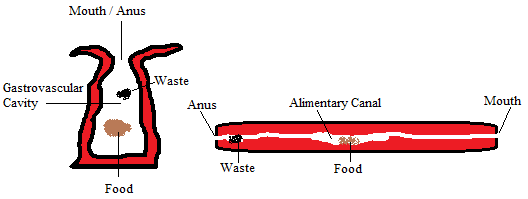BIO 112 Notes: Animal Nutrition
Categories of nutrition that animals fall under
Food is taken in, taken apart, and taken up in the process of animal nutrition.
In general, animals fall into three categories.
Herbivores, which eat mainly plants and algae.
Carnivores, which eat other animals.
And omnivores, which regularly consume animals as well as plants or algae.
Overall, most animals are also opportunistic feeders.
Essential nutrients
Essential nutrients are required by cells and must be obtained from dietary sources.
There are four classes of essential nutrients:
essential amino acids
essential fatty acids
vitamins
minerals
An example of an essential amino acid is methionine. An essential fatty acid is linoleic acid (LA), which is an omega-6 fatty acid. An example of a vitamin is Vitamin C, which is found in fruits. An example of a mineral is calcium, which is found in bones.
Stages of food processing
Food processing can be divided into four distinct stages
Ingestion
Digestion
Absorption
Elimination
Ingestion is the act of eating or feeding. Digestion is the process of breaking down food into molecules small enough to absorb. Absorption is the uptake of nutrients by body cells. Elimination is the passage of undigested material out of the digestive system.
Food processing: ingestion, digestion, absorption, elimination
Difference between intracellular and extracellular digestion
In intracellular digestion, food particles are engulfed by phagocytosis.
Extracellular digestion is the breakdown of food particles outside of cells.
Intracellular digestion takes place in unicellular organisms such as protozoans while extracellular digestion occurs in animals and fungi.
Types of digestive compartments found in animals using extracellular digestion
Animals with simple body plans have a gastrovascular cavity that functions in both digestion and distribution of nutrients.
More complex animals have a complete digestive tract or an alimentary canal with a mouth and an anus. The alimentary canal can have specialized regions that carry out digestion and absorption in a stepwise fashion.
Simple body plan: gastrovascular cavity. Complex body plan: alimentary canal (specialized)

Evolutionary adaptations of the vertebrate digestive system
Dentition, an animal’s assortment of teeth, is one example of structural variation reflecting diet. The success of mammals is due in part to their dentition, which is specialized for different diets.
Vertebrates also have stomach and intestinal adaptations. Herbivores and omnivores generally have longer alimentary canals than carnivores, reflecting the longer time needed to digest vegetation.
Mutualistic adaptations in humans have also been formed to correlate with diet. Some intestinal bacteria produce vitamins; others regulate the development of intestinal epithelium and the function of the innate immune system.
Many vertebrates also host mutualistic bacteria and protists in the fermentation chambers of their alimentary canals. These microorganisms can digest cellulose to simple sugars and other compounds.
Dentition: an animal’s assortment of teeth
Herbivores and omnivores: have longer alimentary canals
Intestinal bacteria: produce vitamins
Mutualistic bacteria: digest cellulose in some animals
 Knowt
Knowt
